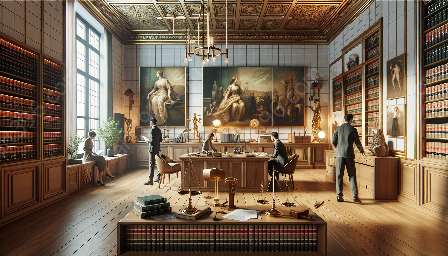Visual art is a powerful mode of expression that often intersects with concepts of freedom of speech and artistic freedom. The First Amendment to the United States Constitution has significant implications for the creation, display, and regulation of visual art and design. Understanding the application of the First Amendment to various forms of visual art and design requires a nuanced exploration of the intersection between art and first amendment rights, as well as the legal landscape of art law.
First Amendment: Protection of Expression
The First Amendment of the United States Constitution protects the freedom of speech and expression. This includes the right to create, display, and consume visual art without undue censorship or restrictions imposed by the government or other entities. From paintings and sculptures to graphic design and digital art, the First Amendment plays a crucial role in safeguarding the rights of artists to convey their messages and ideas through their creations.
Visual Art and First Amendment Rights
Visual art, as a form of expression, often challenges societal norms and provokes debate. The First Amendment grants artists the right to push boundaries and explore contentious or controversial subjects through their art. Whether addressing political issues, social commentary, or personal expression, visual artists are protected by the First Amendment in their pursuit of creative freedom.
- Political Art: Artists often use their work to engage with political discourse and critique systems of power. The First Amendment ensures that political art is shielded from government intervention, allowing artists to express their viewpoints without fear of censorship or retribution.
- Social Commentary: Visual art frequently serves as a platform for social commentary, addressing issues such as inequality, discrimination, and human rights. First Amendment protections enable artists to use their creations as a means of sparking dialogue and promoting social change.
- Controversial Subject Matter: Art that delves into controversial or provocative themes is safeguarded by the First Amendment, allowing artists to delve into challenging topics and stir emotions without facing undue suppression.
Art Law and Legal Landscape
Art law encompasses the legal framework that governs the creation, distribution, ownership, and protection of visual art and design. When examining the application of the First Amendment to visual art, it is essential to consider how art law intersects with first amendment rights and the broader legal landscape.
Legal Protections: The First Amendment extends its protections to visual artists, shielding their work from censorship and ensuring a space for artistic expression that is free from undue restrictions. This legal foundation allows artists to create and exhibit their work with confidence in their constitutional rights.
Intellectual Property: Art law encompasses intellectual property rights, including copyright and trademark protections for visual art and design. Understanding the intersection between these protections and first amendment rights is critical for artists seeking to safeguard their creations while exercising their expressive freedoms.
Censorship and Public Display: The First Amendment places limitations on the ability of governmental bodies and public institutions to censor or suppress visual art, particularly in public spaces. First Amendment considerations are central to the regulation of public artworks and exhibitions, ensuring that artists can display their work without unwarranted interference.
Conclusion
The application of the First Amendment to various forms of visual art and design is a multifaceted and dynamic aspect of art and first amendment rights. By recognizing the inherent link between artistic expression and free speech, as well as considering the legal protections and challenges within art law, individuals can gain a comprehensive understanding of how the First Amendment influences the world of visual art.

